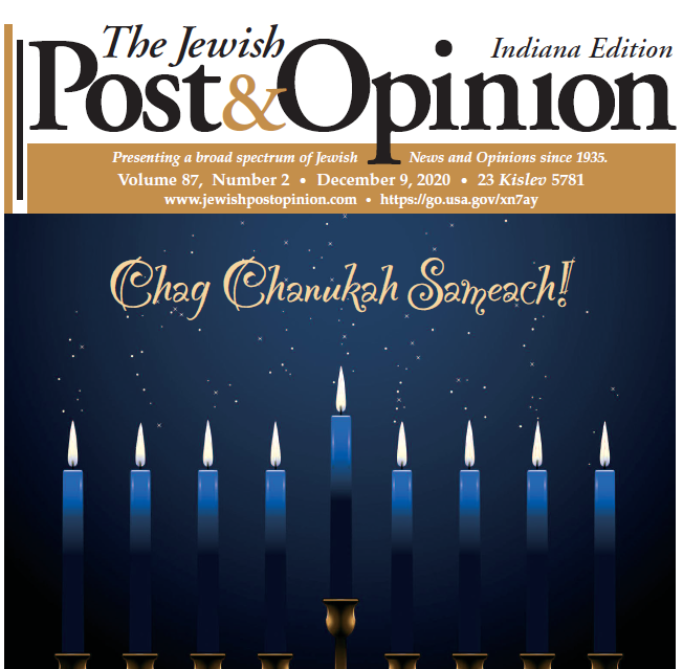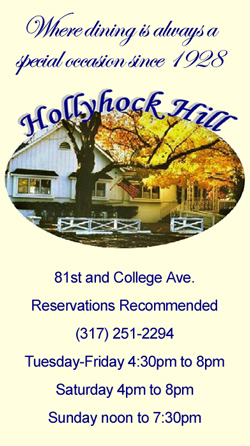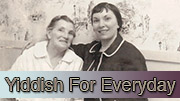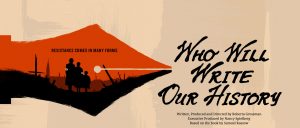
By Miriam L. Zimmerman
Multitalented filmmaker Roberta Grossman just completed a feature documentary, Who Will Write Our History (WWWOH)? Having seen other Holocaust and Jewish-themed films by Ms. Grossman, including 2008’s Blessed Is the Match: The Life and Death of Hannah Senesh and 2013’s Hava Nagila, The Movie, I can think of no other filmmaker better suited for this film than she. Grossman wrote, produced, and directed this important film. For my earlier article about WWWOH while still in production, browse to https://jewishpostopinion.com/wp-content/uploads/2016/07/NAT_7-15-16FFF.pdf (pgs 15-16).
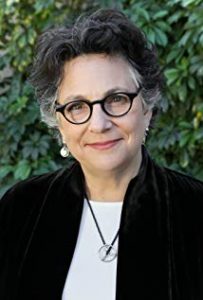
Writer, Producer and Director Roberta Grossman
The World Premier of WWWOH occurred in the summer of 2018 in the Palo Alto, Calif., venue of the Jewish Film Institute’s San Francisco Jewish Film Festival. Unfortunately, I missed it. Fortunately, I was able to view it online before its current national release on Jan. 27, 2019, International Holocaust Remembrance Day.
Based on the book by Samuel D. Kassow, Ph.D., Who Will Write Our History? Rediscovering a Hidden Archive from the Warsaw Ghetto, the film faithfully reenacts the story of how historian Dr. Emanuel Ringelblum’s group, Oyneg Shabes, or “Joy of Sabbath,” documented the Warsaw Ghetto experience. The film “mixes the writings of the Oyneg Shabes archive with new interviews, rarely seen footage and stunning dramatizations to transport us inside the Ghetto and the lives of these courageous resistance fighters.”
This clandestine group included journalists, artists and art critics, statisticians, historians, rabbis, scholars and intellectuals, teachers and authors, social workers and economists; secular as well as religious Jews; and children as well as adults. They fought the Nazis with words and spirit, not with weapons. Dr. Ringelblum wanted to ensure that the world would remember Jews not through the distorted lens of Nazi films, but in terms of the Jews’ own lived experience.
The Germans sent film crews into the Warsaw Ghetto to create propaganda for the benefit of the Polish people, whom they wanted to “protect” from the Jews. Their propaganda depicted Jews as vermin, as not interested in personal hygiene, as scum. Ringelblum did not want this perspective to characterize how Jews would be thought of in the future.
“Will the Germans write our history, or will we write our history?” The historian’s vision was to ensure that Jews documented their experience in the Ghetto so that Jews defined their legacy, not the Nazis. Dr. Ringelblum’s greatness, according to the film, was that he brought together an extraordinarily talented group of people and let them do their thing.
Ringelblum placed value on the lives of ordinary people. He felt that the history of the Jewish people was not the history of rabbis and philosophers, but of the whole people. He loved the masses and the language of the masses, Yiddish. Thus, he wanted his group to record everyday experience. The actors reflect Dr. Ringelblum’s approach, toggling between Yiddish and Polish, depending on context. The film is subtitled and available in English, Polish, Hebrew, French, German, Italian, Spanish, Russian and closed captioned.
The members were given notebooks and stipends so that they could record eyewitness testimony. They wrote reports from the streets as well as literary pieces, poetry, jokes, diaries, commissioned works about refugees from surrounding areas, illnesses, smuggling, the situation of the Jewish child, the role of women, and the songs of beggars. Everything submitted “had to pass the critical eye of Dr. Ringelblum,” according to Hersh Wasser, one of Dr. Ringelblum’s two executive secretaries.
Everything had to be kept secret. Members did not know one another. Dr. Ringelblum kept in touch with them via Hersh Wasser and his other executive secretary, Israel Lichtenstein. Only those three knew where the archives lay hidden. They had to act clandestinely, because documenting German crimes was punishable by death.
In addition to the writings, Dr. Ringelblum instructed some of the members of the group to collect items from the Ghetto to add to the archive. Such artifacts included pronouncements from the German government, tickets to cultural events, ration coupons, letters and postcards, photos, theatre posters, labels on Ghetto goods, the obligatory white ribbons with the Jewish star worn on the arm, newspapers, and even candy wrappers; in short, the detritus of any recycling bin from today’s world. Surprisingly, the Ghetto published six Yiddish dailies and two Polish dailies. These artifacts served as further evidence of the living conditions in the Warsaw Ghetto.
A better term would be “dying conditions” in the Warsaw Ghetto. According to the U.S. Holocaust Memorial Museum (USHMM), 80,000 Jews perished in the Warsaw Ghetto from the appalling conditions; overcrowding, starvation, disease, and shootings by the Nazis. “By August 1941, more than 5,000 people a month succumbed to starvation and disease.” Most of the original 50-60 members of the Oyneg Shabes group did not survive.
Rachel Auerbach was one of only three survivors. Dr. Ringelblum was not one of them. Thrice-nominated Academy Award actress Joan Allen narrated the film in Rachel Auerbach’s voice, using Auerbach’s words written after the war. Academy Award winner Adrien Brody supplied the voice of Dr. Ringelblum.
As an educator, my top criterion for a Holocaust documentary is whether or not I plan to show the film to my students. The film dramatically portrayed issues so difficult for students to understand, such as the early persecutions and humiliations, the gradual creation of a ghetto, the rationale for smuggling, the effects of starvation rations on a population, and overcrowding.
In 1939, about 30 percent of prewar Warsaw was Jewish, about 350,000 people. It was the largest Jewish community in Europe. The Nazis divided the city into three ethnicities: German, Polish, and Jewish. To create the Ghetto, the Nazis transferred Poles out and Jews into the designated area, only 1.3 square miles. On Nov. 15, 1940, the Nazis sealed the Ghetto.
Subsequently, the Warsaw Ghetto also served as a transit camp, as the Nazis dumped Jews from the surrounding area into the Ghetto before deporting them to an extermination camp (usually Treblinka). At its height, about 450,000 Jews were crammed into that same area of 1.3 square miles, resulting in 7.2 people per room.
I predict that the vividness of the footage and the high production values throughout the film will quickly engage and sustain today’s student; no mean feat given competing technologies that I believe have changed the ways in which people’s brains process images.
Ms. Grossman seamlessly wove together archival footage, dramatic reenactments, and scholarly interviews. The scholarly talking heads did not dominate the film nor interfere with the dramatic tension established by the actors. Technology allowed her to superimpose her actors onto archival footage. The result is that the viewer feels as if the actors are, in fact, living in the horrific conditions of the Warsaw Ghetto.
Seeing this technology at work in the film reminded me of the admonition of Holocaust survivor and activist Elie Wiesel, of blessed memory. Wiesel was against representing the Holocaust in artistic form. He warned that since art, by its very nature, transforms and beautifies, there is a danger it will transform the Holocaust into something it is not, something beautiful. He was adamantly against fictionalizing the Holocaust.
I believe Ms. Grossman is cognizant of Wiesel’s admonition. She wrote in her Director’s Statement that, “While striving to avoid ‘tricks’ that would ‘fool’ an audience, the film does employ transparent visual effects such as compositing actors shot against green screen with archival footage. The goal here is to bring the past to life while balancing against the high standards for veracity in a documentary (emphasis added). To achieve this goal, we blended archival and dramatic footage, pulling from the tools of dramatic feature storytelling (emphasis added). While fully aware of the complexity of these techniques, I reached for these visual tools because Who Will Write Our History tells the story of a place that no longer exists (the Warsaw Ghetto), about people who are long dead, and about a period of history captured primarily in black-and-white film and mostly by Nazi propaganda photographers and cameramen. I want people not simply to learn from the film, but to be engaged and deeply moved.”
Grossman justifies her use of dramatic storytelling as a means of achieving her goal, to create an engaging film that will be seen. My dilemma is to decide if the advantages of using dramatic storytelling outweigh any disadvantages. One could argue that a documentary is no longer a documentary to the extent that fictional devices are inserted into the work. Questions for me arise: is this film a work of art or is it a documentary? If the former, is Wiesel’s warning relevant? Is the film sufficiently nonfiction such that an educator like me will not have to worry that students will become confused, not able to distinguish archival sequences from dramatic enactments? Will the use of this technology render future audiences skeptical about the veracity of the archival footage because so much of the images are created and thus fictional?
Undeniably, the film is historically correct. Grossman added another layer of rigor by employing scholars to help her and her crew achieve historical authenticity. “In order to ground the film’s cinematically dramatized scenes in historical accuracy, the production design team worked with scholars for six months before we started filming. This process ensured that every pen, shoelace, and wall color was spot-on for the period.” In addition, “The words spoken by actors inthe film come directly from the writing of the Oyneg Shabes Archive and/or in the case of the film’s narrator, Rachel Auerbach, from her post-war writing.”
Just before the Warsaw Ghetto Uprising, Dr. Ringelblum realized the time had come to hide the precious archive. In milk cans and boxes, he buried the archive in three different caches in the Warsaw Ghetto. After the war, just two of the caches were found. The third is thought to be located under the Chinese Embassy in Warsaw. “….the archive comprises some 35,000 pages, including documents, materials from the underground press, photographs, memoirs, belles lettres, and much more.”—USHMM website, “The Warsaw Ghetto Oyneg Shabes—Ringelblum Archive Catalog and Guide.”
Today, the Jewish Historical Institute in Warsaw (JHIW) houses the archive’s writings and artifacts. According to JHIW, “On January 27, 2019, during International Holocaust Remembrance Day, the film will be screened worldwide – in cinemas, theatres, churches, synagogues, mosques, universities, museums, culture centers.” On that date, it will screen in Indianapolis as well. See schedule at http://whowillwriteourhistory.com/see-the-film/
JHIW continues, “At the UNESCO headquarters in Paris, an audience of about 1500 diplomats from all around the world will take part in a discussion with Nancy Spielberg [executive producer], Roberta Grossman, Samuel D. Kassow and Stephen Smith, head of the USC Shoah Foundation. The discussion will be transmitted live in social media, on the film’s profile page.”
Grossman pointed out that “In 1999, three document collections from Poland were included in UNESCO’s Memory of the World Register: the masterpieces of Chopin, the scientific works of Copernicus and the Oyneg Shabes Archive.”
By accomplishing its goal of collecting and recording thousands of eyewitness accounts of Jewish life in the Warsaw Ghetto and the surrounding areas, Dr. Ringleblum’s Oyneg Shabes archive defeated Nazi propaganda with truth. UNESCO elevated the accomplishments of Oyneg Shabes with the artistic accomplishments of Chopin and the scientific truths of Copernicus.
Grossman concluded her Director’s Statement with the following: “Historians concur that the Oyneg Shabes Archive is the richest cache of eyewitness, contemporaneous accounts to survive the Holocaust. Despite its importance, the archive remains largely unknown outside academic circles. It is my hope that Who Will Write Our History will change that in the way that only a film can do, by making the story accessible to millions of people around the world.”
After watching the film twice and writing this analysis, I have decided to do what I can to help Roberta Grossman accomplish her goal, by showing it to my Holocaust class. It is a superb film, meeting the highest standards of historical accuracy. At the same time, it includes enough elements of dramatic storytelling to ensure that today’s technologically saturated student will stay engaged and interested throughout. I highly recommend this film.
Dr. Zimmerman is professor emerita at Notre Dame de Namur University (NDNU) in Belmont, Calif., where she continues to teach the Holocaust course. She can be reached at mzimmerman@ndnu.edu.
